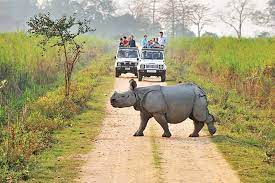The Kaziranga National Park, tucked away in northeastern India, is evidence of the nation’s dedication to protecting its abundant biodiversity. Known for its breathtaking scenery and incredible conservation efforts, especially for the endangered Indian one-horned rhinoceros, this UNESCO World Heritage Site in Assam is well-known. Extending along the floodplains of the Brahmaputra River, Kaziranga is home to various habitats, providing a sanctuary for both nature lovers and animal enthusiasts.
Rich Biodiversity: The Pride of Kaziranga
One of the critical attractions of Kaziranga is its unparalleled biodiversity. The park has various flora and fauna, including mammals, birds, reptiles, and amphibians. However, its most famous resident is the Indian one-horned rhinoceros. Kaziranga houses the largest population of this majestic species globally, making it a critical sanctuary for their conservation.
Apart from the rhinoceros, the park shelters iconic species like the Bengal tiger, Asian elephant, wild water buffalo, and swamp deer. The varied landscape, comprising tall grasslands, dense forests, and wetlands, provides a conducive environment for these creatures to thrive. Additionally, Kaziranga is a birdwatcher’s paradise, with over 480 species of birds, including migratory ones, gracing its skies.
Conservation Success: A Model for Wildlife Preservation
Successful wildlife protection is now closely associated with Kaziranga National Park. Established in 1905 as a response to the dwindling rhinoceros population, the park’s efforts have not only saved the one-horned rhinoceros from the brink of extinction but have also led to the overall enhancement of the region’s ecological health.
The park’s management employs various conservation strategies, including anti-poaching measures, habitat protection, and community engagement. Implementing modern technology, such as drones and camera traps, has significantly bolstered anti-poaching efforts, ensuring the safety of the park’s inhabitants. Moreover, the involvement of local communities in conservation initiatives has fostered a sense of responsibility and ownership, creating a harmonious relationship between humans and wildlife.
Challenges and Initiatives: Navigating the Conservation Landscape
While Kaziranga’s conservation story is undoubtedly inspiring, it has its challenges. The park faces constant threats from poaching, habitat loss, and human-wildlife conflict. Rapid industrialization and infrastructural development in the surrounding areas pose a risk to the delicate balance that sustains the park’s ecosystems.
Various initiatives have been undertaken to address these challenges. Conservation organizations, governmental bodies, and local communities collaborate to mitigate the impact of these threats. Sustainable tourism practices are being promoted to generate awareness and funds for ongoing conservation efforts.
Conclusion: A Natural Heritage to Cherish
Kaziranga National Park is a testament to the power of dedicated conservation efforts to preserve our planet’s natural wonders. The park’s rich biodiversity and its success in rhinoceros conservation make it a jewel in India’s natural heritage. The world struggles to preserve biodiversity. Kaziranga offers hope, showing that united efforts and community involvement can protect Earth’s diverse ecosystems for future generations.


